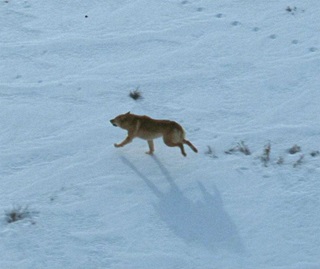What are wild dogs?
 A wild dog is any dog living in the wild, including feral dogs (Canis lupus familiaris), dingoes (Canis lupus dingo) and their hybrids. Wild dogs can have significant impacts on livestock, especially sheep. As a result, they have been identified as a priority pest animal under the 11 Regional Strategic Pest Animal Management Plans developed by Local Land Services. It is therefore necessary to manage wild dogs under the General Biosecurity Duty of the Biosecurity Act 2015.
A wild dog is any dog living in the wild, including feral dogs (Canis lupus familiaris), dingoes (Canis lupus dingo) and their hybrids. Wild dogs can have significant impacts on livestock, especially sheep. As a result, they have been identified as a priority pest animal under the 11 Regional Strategic Pest Animal Management Plans developed by Local Land Services. It is therefore necessary to manage wild dogs under the General Biosecurity Duty of the Biosecurity Act 2015.
The General Biosecurity Duty requires any person dealing with biosecurity matter (such as wild dogs), and who knows or ought to know of the biosecurity risks posed by that biosecurity matter, to take measures to prevent, minimise or eliminate the risk as far as is reasonably practicable. This means that the occupier of lands (both private and public) is required to take all practical measures to minimise the risk of any negative impacts of wild dogs on their land or neighbouring lands.
Wild dogs may have both positive and negative impacts on the environment but these interactions and any net outcomes are not well understood. Predation by wild dogs can reduce the impacts of overgrazing in arid and semi-arid ecosystems by regulating the abundance of native and exotic herbivores. Under some circumstances, wild dogs may also suppress the abundance or activity of other pest animals such as cats and foxes. Conversely, under some circumstances, predation by dogs may have significant direct impacts on threatened species such as koalas.
Dingoes in New South Wales
Dingoes were introduced into Australia from Asia by humans around 4,000 years ago. They established across the mainland and on many offshore islands, probably assisted by Aboriginal people. Their introduction has been linked to the extinction of the thylacine (Tasmanian tiger) and the Tasmanian devil on the mainland.
Research has shown that over 90% of wild dogs in New South Wales are hybrids. However, although these animals pose a threat to livestock on agricultural land, they can also fulfil the ecological role of the dingo in natural environments.
Predation and hybridisation by feral dogs (Canis lupus familiaris) has been listed as a key threatening process in New South Wales by the NSW Scientific Committee.
Managing wild dogs in our national parks
The General Biosecurity Duty for wild dogs is directly informed by the NSW Wild Dog Strategy, which promotes a balance between managing wild dogs in areas where they have negative impacts and preserving the ecological role of dingoes. The conservation of dingoes is listed under the goals of the strategy and is to be achieved by having Wild Dog Management Plans focus control on areas where the risk of negative impacts is greatest and not undertaking control in other parts of the landscape with a low risk of negative impacts from wild dogs, to allow dingoes to fulfil their natural ecological role.
NPWS develops wild dog management plans where a high risk of negative impacts from wild dogs is identified. These plans are developed in accordance with the NSW Guidelines for the Preparation and Implementation of Wild Dog Management Plans (PDF 339KB).
To help manage wild dogs in our national parks, we:
- develop state and regional pest management strategies
- carry out pest control programs
- work with other agencies.
The Office of Environment and Heritage (OEH) and National Parks and Wildlife Service (NPWS) undertake wild dog management programs in many national parks and reserves along the coast, Great Diving Range, Northern, Central and Southern Tablelands and in the far north-west of the state. Because wild dogs are widespread and eradication is not feasible, priority programs for wild dog control have been established. These are outlined in our regional pest management strategies.
The main objective of these programs is to minimise the impacts of wild dogs on livestock on adjoining lands. Management programs are also undertaken to minimise the risks that wild dogs pose to park visitors and staff.
We work closely with other public land managers, including the Department of Primary Industries, Local Land Services, the Forestry Corporation of NSW and park neighbours to deliver cooperative control programs. This includes the development of the wild dog management strategies.
The NSW Wild Dog Management Strategy 2022–2027 identifies specific actions to ensure we maintain and build on existing wild dog management, policy, research and training approaches in New South Wales.
Read more about our wild dogs parks policy.
Control methods
Under the Biosecurity Act 2015, pest animal management is recognised as a shared responsibility for all community members. Both private and public landowners are required to control wild dogs to minimise the risk of any negative impacts on their lands or that of their neighbours.
Control methods for wild dogs in national parks include ground baiting, aerial baiting, trapping, shooting and fencing. These methods are clearly described in theCode of Practice and Standard Operating Procedures for the humane control of wild dogs. Management is most effective when a combination of methods is used and when land managers work cooperatively.

